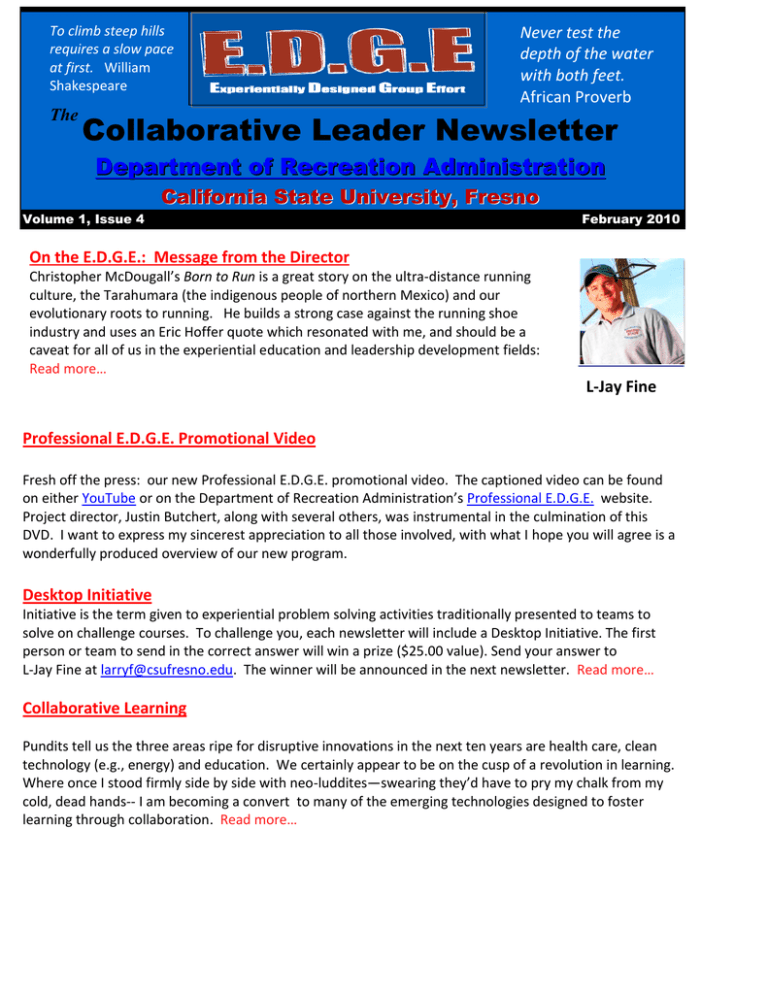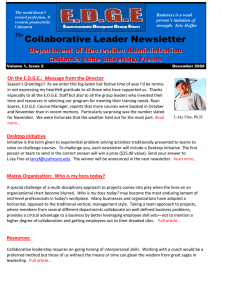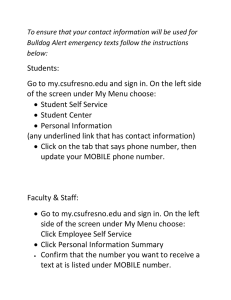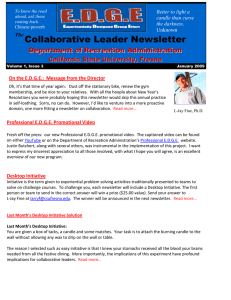Collaborative Leader Newsletter D e
advertisement

To climb steep hills requires a slow pace at first. William Shakespeare The Never test the depth of the water with both feet. African Proverb Collaborative Leader Newsletter Department of Recreation Administration California State University, Fresno Volume 1, Issue 4 February 2010 On the E.D.G.E.: Message from the Director Christopher McDougall’s Born to Run is a great story on the ultra-distance running culture, the Tarahumara (the indigenous people of northern Mexico) and our evolutionary roots to running. He builds a strong case against the running shoe industry and uses an Eric Hoffer quote which resonated with me, and should be a caveat for all of us in the experiential education and leadership development fields: Read more… L-Jay Fine Professional E.D.G.E. Promotional Video Fresh off the press: our new Professional E.D.G.E. promotional video. The captioned video can be found on either YouTube or on the Department of Recreation Administration’s Professional E.D.G.E. website. Project director, Justin Butchert, along with several others, was instrumental in the culmination of this DVD. I want to express my sincerest appreciation to all those involved, with what I hope you will agree is a wonderfully produced overview of our new program. Desktop Initiative Initiative is the term given to experiential problem solving activities traditionally presented to teams to solve on challenge courses. To challenge you, each newsletter will include a Desktop Initiative. The first person or team to send in the correct answer will win a prize ($25.00 value). Send your answer to L-Jay Fine at larryf@csufresno.edu. The winner will be announced in the next newsletter. Read more… Collaborative Learning Pundits tell us the three areas ripe for disruptive innovations in the next ten years are health care, clean technology (e.g., energy) and education. We certainly appear to be on the cusp of a revolution in learning. Where once I stood firmly side by side with neo-luddites—swearing they’d have to pry my chalk from my cold, dead hands-- I am becoming a convert to many of the emerging technologies designed to foster learning through collaboration. Read more… Resources: In keeping with the theme on collaborative learning, two on-line resources promise to add tremendously to learning opportunities and expanding dialogue, cultural literacy and a deeper understanding of our humanity. Read more… Full Articles On the E.D.G.E.: Message from the Director Christopher McDougall’s Born to Run is a great story on the ultra-distance running culture, the Tarahumara (the indigenous people of northern Mexico) and our evolutionary roots to running. He builds a strong case against the running shoe industry and uses an Eric Hoffer quote which resonated with me, and should be a caveat for all of us in the experiential education and leadership development fields: Every great cause begins as a movement, becomes a business, and eventually degenerates into a racket. (The True Believer: Thoughts on the Nature of Mass Movements). Experiential education emerged as a solution to a problem in learning; namely passive methods such as formal lessons and lectures failed to properly engage students and meet the needs of a variety of learning styles. Those involved in early iterations of challenge courses and experiential education such as Project Adventure’s Karl Rohnke and Outward Bound’s Kurt Hahn were passionate practitioners targeting their efforts toward youth, particularly those at-risk. As the methodology caught on, many saw the value of transferring these learning activities, including facilitation skills, to the corporate world. Nothing wrong with that if we can create better leaders. It becomes a concern when we dilute the power of experiential education, particularly with the facilitation skills, with a cookie-cutter approach to delivery. When a ropes course experience turns into little more than a Disneyland ride then we’ve become a racket. Fortunately, we are a long ways from that but it’s always worth keeping Hoffer’s caveat in mind. I suppose shameless self-promotion is just shy of becoming a racket so forgive me: Under the strong urging of my wife to enter the 21st century, the E.D.G.E. Program will be entering the social media era with a Facebook page. Please become a fan and post your observations on team building, leadership, and collaboration. Once again, my deepest appreciation to Dr. Nancy Nisbett for her keen editing skills; without which I would not have the confidence to send this newsletter out. We welcome your feedback and can assure you that your comments will be addressed. Feel free to send your thoughts and concerns to L-Jay Fine larryf@csufresno.edu or Ryan Soares rsoares@csufresno.edu. Happy Adventures! LJ Desktop Initiative Initiative is the term given to experiential problem solving activities traditionally presented to teams on challenge courses. To challenge you, each newsletter will include a Desktop Initiative. The first person or team to send in the correct answer will win a prize ($25.00 value). Send your answer to L-Jay Fine at larryf@csufresno.edu. The winner will be announced in the next newsletter. Last Month’s Desktop Initiative Solution Last Month’s Desktop Initiative: “A miner has a 40 lb. stone that is used for weighing ore on a balance scale. A friend borrows the stone to weigh ore from a neighboring claim and, while caring for the stone, it gets dropped and broken into 4 pieces. Each piece is a different size and weight, but all weights are exact to the nearest precise pound. The miner is not disappointed, because the new weights permit ore to be weighted pound by pound from 1 – 40 lbs. What are the 4 stone’s weights?” (101 of the Best Corporate Team Building Activities by Simon Priest and Karl Rohnke, Kendall-Hunt, Dubuque, 2000) Answer to last month’s Desktop Initiative: The four stones weigh 1, 3, 9, and 27 pounds respectively. These are all you would need to come up with every combination up to 40 lbs. For example 14 = 27-9-3-1 or 17 = 27-9-1. Hope you don’t mind if I don’t type out the entire list. Again, thanks for this puzzle goes to Simon Priest and Karl Rohnke. Today’s Desktop Initiative Today’s Desktop Initiative is a cryptex (aka Dan Brown’s DaVinci Code) IWSEKIEANDRNOEVA (hint: after completing this puzzle my students would believe this to be true; unfortunately none has solved it after five years). Collaborative Learning Pundits tell us the three areas ripe for disruptive innovations in the next ten years are health care, clean technology (e.g., energy) and education. We certainly appear to be on the cusp of a revolution in learning. Where once I stood firmly side by side with neo-luddites—swearing they’d have to pry my chalk from my cold, dead hands-- I am becoming a convert to many of the emerging technologies designed to foster learning through collaboration. Though I’ll never be an early adopter again (I had quite a bad experience with clickers), recognizing the incredible versatility and power inhered in these technologies it would be irresponsible not to participate in these new learning methods. Borrowing from the Enterprise 2.0 idea, we can readily view this new trend as Learning 2.0. The opportunities to learn are so overwhelming to be almost intimidating. We are likely to see two developments in learning in the 21 st century. First, individuals from all walks of life and geography, with the right initiative, can learn virtually anything on their own. Secondly, learning in traditional settings will be transformed from the sage on the stage model to a collaborative learning model. Namely, innovations will center on team-based learning, case studies, and problem based learning, all incorporating an on-line platform for deeper conversations and more give and take. Since collaborative leadership is so dependent on the mindset and practices of a learning organization, this will be an on-going topic we will re-visit. I invite you to contribute to this conversation on learning by emailing your thoughts to larryf@csufresno.edu. Resources: In keeping with the theme on collaborative learning, two on-line resources promise to add tremendously to learning opportunities and expanding dialogue, cultural literacy and a deeper understanding of our humanity. Academic Earth provides numerous video lecture series by topic and discipline from some of the top universities and subject matter experts. Several of these are full semester’s worth of videos. iTunes University provides a repository of podcasts and videos from colleges and universities. Touted as: Learn anything, anytime, anywhere: “iTunes U — a powerful distribution system for everything from lectures to language lessons, films to labs, audiobooks to tours — is an innovative way to get educational content into the hands of students” (Apple Website).


